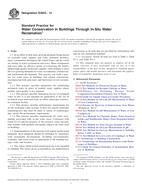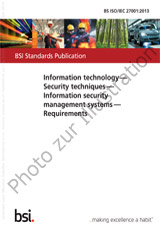Wir benötigen Ihre Einwilligung zur Verwendung der einzelnen Daten, damit Sie unter anderem Informationen zu Ihren Interessen einsehen können. Klicken Sie auf "OK", um Ihre Zustimmung zu erteilen.
ASTM E2635-14
Standard Practice for Water Conservation in Buildings Through In-Situ Water Reclamation
Automatische name übersetzung:
Standard Praxis für Wasserschutz in Gebäuden durch In-Situ Wasserrückgewinnungs
NORM herausgegeben am 1.3.2014
Informationen über die Norm:
Bezeichnung normen: ASTM E2635-14
Anmerkung: UNGÜLTIG
Ausgabedatum normen: 1.3.2014
SKU: NS-45777
Zahl der Seiten: 11
Gewicht ca.: 33 g (0.07 Pfund)
Land: Amerikanische technische Norm
Kategorie: Technische Normen ASTM
Kategorie - ähnliche Normen:
Die Annotation des Normtextes ASTM E2635-14 :
Keywords:
building, green building, reclaimed water, sustainability, sustainable building, water conservation, water reuse, water stewardship, ICS Number Code 13.060.25 (Water for industrial use)
Ergänzende Informationen
| Significance and Use | ||
|
4.1 General—As the world’s population increases, so does the need for water to meet various needs, as well as the need to manage wastewater. Already accepted and endorsed by the public in many urban and agricultural areas, properly implemented nonpotable water reuse projects can help communities meet water demand and supply challenges without any known significant health risks. 4.1.1 Many communities throughout the world are approaching, or have already reached, the limits of their available water supplies; water reuse has become necessary for conserving and extending available water supplies. Where the availability of water limits development, water reuse can facilitate social and economic developmental needs in an environmentally responsible manner. 4.1.2 Many communities are also approaching, or have already reached, the limit of available water treatment facilities. New facilities and infrastructure are costly. In-situ water reuse reduces load on community wastewater facilities. 4.1.3 Additionally, many communities face increased security issues in safeguarding water sources and treatment. In-situ systems provide for redundancies and diversified systems that decrease security issues associated with centralized facilities. 4.2 Sustainable Development—This practice is consistent with the general principles for sustainability relative to building as identified in Guide E2432. It addresses the environmental, economic, and social principles as follows: 4.2.1 Environmental—Water is a natural resource. Sustainable use of natural resources requires that the resource is utilized efficiently and in a manner that preserves or enhances the quality of that resource and does not adversely alter the balance between the renewable resource and the rate of consumption for building-related purposes. Utilization of technologies, such as in-situ water reclamation systems that help conserve water enable more sustainable use of water than standard construction. 4.2.2 Economic: 4.2.2.1 Direct Costs/Benefits—Direct cost/benefits include first costs/benefits as well as operating costs/benefits such as: utility costs, maintenance and repair costs, and costs associated with replacement of component materials and systems. Utilization of technologies, such as in-situ water reclamation systems that help reduce building demand for potable water can reduce utility costs and prevent moratoriums on new construction. 4.2.2.2 Indirect Cost/Benefits—Sustainable building practices seek to identify associated external costs/benefits, minimize associated external costs, and maximize external benefits. Utilization of technologies, such as in-situ water reclamation systems that help reduce the amount of wastewater discharge from a building reduce demands on municipal water infrastructure. This includes costs for centralized treatment and distribution. Significant energy is expended for treatment and distribution of water. For example, in California, an estimated 19 % of electricity, 32 % of natural gas consumption, and 88 billion gallons of diesel fuel annually power the treatment and distribution of water and wastewater.6 |
Range of Energy |
|
|
Water-Use Cycle Segments |
Low |
High |
|
Water Supply and Conveyance |
0 |
14 000 |
|
Water Treatment |
100 |
16 000 |
|
Water Distribution |
700 |
1 200 |
|
Wastewater Collection and Treatment |
1 100 |
4 600 |
|
Wastewater Discharge |
0 |
400 |
|
Recycled Water Treatment and Distribution |
400 |
1 200 |
4.2.2.3 Social—Sustainable buildings protect and enhance the health, safety, and welfare of building occupants. Utilization of technologies, such as in-situ water reclamation systems that help diversify and decentralize critical health, safety, and welfare infrastructure help promote the safety and security of the general public.



 BS EN 15075:2013..
BS EN 15075:2013..
 Cookies
Cookies
